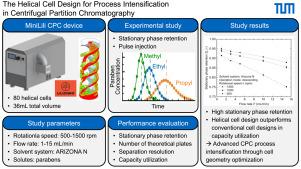The helical cell design for process intensification in centrifugal partition chromatography
IF 3.9
3区 工程技术
Q3 ENERGY & FUELS
Chemical Engineering and Processing - Process Intensification
Pub Date : 2025-10-08
DOI:10.1016/j.cep.2025.110564
引用次数: 0
Abstract
Centrifugal partition chromatography (CPC) is a liquid–liquid chromatography technique commonly used to separate natural products. Since increasing the CPC separation performance by operational conditions is limited, process intensification in CPC requires optimizing the CPC cell design. This study aims to experimentally investigate the performance of a miniLili CPC device with a novel helical cell design developed by LiliChro (Hungary) and compare it to conventional CPC cell designs. The miniLili CPC device has 80 cells and a volume of 36 mL. Performance is evaluated based on stationary phase retention, number of theoretical plates, and separation resolution. Additionally, “capacity utilization”, defined as a product of stationary phase retention and the cells’ efficiency, is introduced as a new metric to compare the overall performance of CPC devices of different volumes, cell numbers, and cell geometry. Experiments are performed using the Arizona N solvent system and methyl, ethyl, and propyl parabens as solutes. The novel cell design demonstrates high stationary phase retention of 0.9-0.95 at rotational speeds of 1000-1500 rpm and volume flow rates of 1-5 mL/min. Although the resolution in the miniLili CPC device is comparatively lower than that of conventional CPC devices, higher resolutions can be reached by increasing the rotational speed, flow rate, or number of physical cells. Despite this, the capacity utilization of the miniLili CPC device exceeds that of conventional designs within its operating flow rate range. These findings underscore the potential of advanced cell geometries to drive process intensification in CPC, marking a significant step forward in the evolution of high-efficiency CPC.

离心分配色谱过程强化的螺旋池设计
离心配分色谱是一种常用的分离天然产物的液-液色谱技术。由于通过操作条件提高CPC分离性能是有限的,因此CPC的过程强化需要优化CPC单元的设计。本研究旨在实验研究由LiliChro(匈牙利)开发的新型螺旋电池设计的迷你ili CPC装置的性能,并将其与传统CPC电池设计进行比较。miniLili CPC设备有80个细胞,体积为36 mL。性能评估基于固定相保留,理论板数和分离分辨率。此外,“容量利用率”被定义为固定相保留和电池效率的乘积,作为比较不同体积、电池数量和电池几何形状的CPC设备的整体性能的新指标。实验使用亚利桑那N溶剂体系和甲基、乙基和丙基对羟基苯甲酸酯作为溶质进行。在转速为1000-1500 rpm,体积流速为1-5 mL/min时,新型电池的固定相保留率为0.9-0.95。虽然miniLili CPC设备的分辨率比传统CPC设备低,但通过增加转速、流速或物理单元的数量可以达到更高的分辨率。尽管如此,miniLili CPC设备在其工作流量范围内的产能利用率超过了传统设计。这些发现强调了先进细胞几何结构在CPC中推动过程强化的潜力,标志着高效CPC的发展向前迈出了重要一步。
本文章由计算机程序翻译,如有差异,请以英文原文为准。
求助全文
约1分钟内获得全文
求助全文
来源期刊
CiteScore
7.80
自引率
9.30%
发文量
408
审稿时长
49 days
期刊介绍:
Chemical Engineering and Processing: Process Intensification is intended for practicing researchers in industry and academia, working in the field of Process Engineering and related to the subject of Process Intensification.Articles published in the Journal demonstrate how novel discoveries, developments and theories in the field of Process Engineering and in particular Process Intensification may be used for analysis and design of innovative equipment and processing methods with substantially improved sustainability, efficiency and environmental performance.

 求助内容:
求助内容: 应助结果提醒方式:
应助结果提醒方式:


